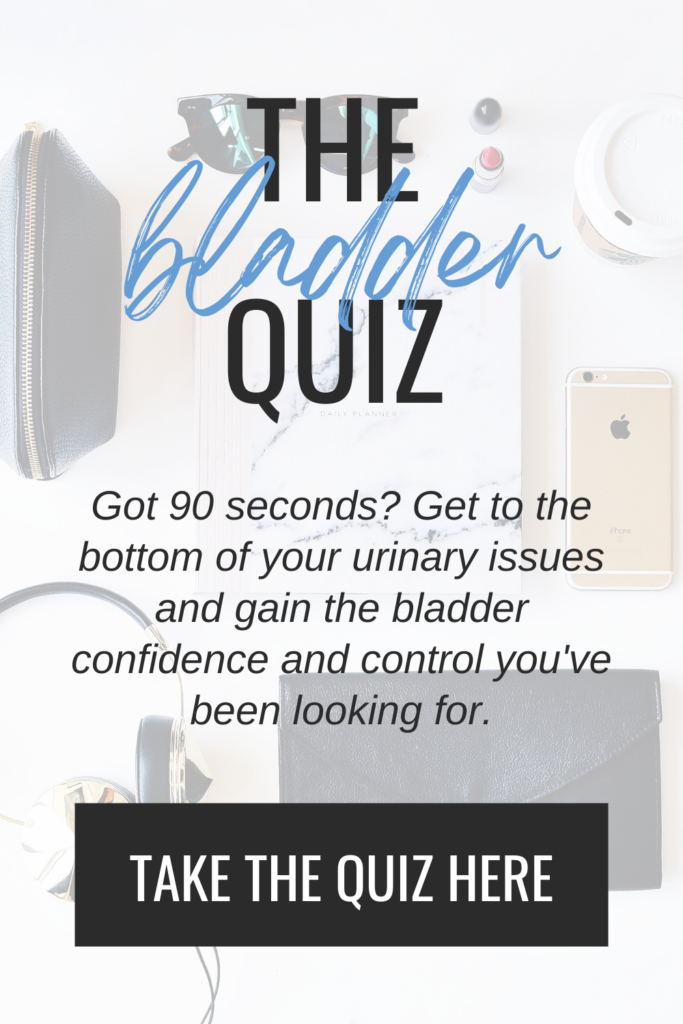Amazon Prime, “set it and forget it!”, “click of a button”…our modern minds are conditioned to expect immediate results and desire instant gratification in nearly every aspect of life. And when it comes our health, specifically that of the pelvic floor, many of us are searching for less leakage, a fixed prolapse, or postpartum healing within those same parameters.
We want fast, easy, preferably painless, convenient if possible, and don’t forget effective.
One in three women complain of urinary leakage, and those with pelvic floor dysfunction tend to be busy moms, boss babes, retired and ready to relax, or a beautiful combo of the above (I know this because I was this woman and I treat these women every day). Inventors know this too, and medical engineers have been working overtime to create too-good-to-be-true tools to help these women with pelvic floor strengthening.
If you know me, then you know I looooooooove the idea of women living life without leakage. And I would also ~never~ turn down a device that helps you get there more efficiently in every sense of the word. But the colorful, fancy, and expensive contraptions you might scroll by in Facebook ads, see in a new wellness center, or hear a girlfriend bring up over drinks might not be as great as they seem.
So at the risk of bursting your bubble orrrrrr maybe seconding what you’ve been suspecting all along, I’m sharing my thoughts and opinions on the popular pelvic floor strengthening tools currently on the market including the pros, cons, and whether or not I would recommend jumping on the bandwagon.
I want nothing more than for Y-O-U to have a strong and healthy pelvic floor that you can be confident in. In order to achieve this, you’ve gotta know where to spend your time, resources, energy, and enthusiasm…because if you’re like me, you’ve got none to waste.
EMSELLA CHAIR
Let’s go big right from the start, shall we? The Emsella chair boasts a “non-surgical, non-invasive treatment for urinary incontinence” by using high intensity focused electromagnetic (HIFEM) energy to deliver “thousands of supramaximal pelvic floor contractions” in a single 30-minute session. I know…wild. You sit on the chair fully clothed and simply allow it do work its magic. The cost is around $300 per session and the chair’s creators recommend at least six sessions to see results.
Pros: Studies are actually showing that the Emsella chair can provide improved pelvic floor strength and less frequency and severity of urinary incontinence. Some users have even reported improvement in pelvic organ prolapse symptoms like pelvic pressure and heaviness. I personally like the potential of this new technology and would like to see where it goes.
Cons: Beyond the $1800 price tag and limited availability (although more and more chairs are popping up in OB/GYN clinics and wellness centers everywhere), pure pelvic floor strength achieved through a passive means doesn’t usually equate to much in the grand scheme of things. For results that last, you also need muscle coordination and control, good bladder habits, posture and breathing strategies, etc, and this chair provides none of those things. Click here to get your FREE GUIDE to those effective pelvic floor strengthening practices.
My Two Cents: I would give the Emsella chair a hard pass 98% of the time. The ~only~ instance I may recommend trying this would be if someone still notices pelvic floor dysfunction after working consistently with a pelvic rehab therapist and they’re trying to avoid more invasive measures.
INNOVO SHORTS
Similar to the Emsella chair, the Innovo Shorts supply neuromuscular electrical stimulation (NMES) to the thighs, glutes, and lower abdomen through six large electrodes built into a pair of spandex shorts. This product boasts “180 perfect kegels in 30 minutes”, and the promise of being “leakage free within 12 weeks” when using the shorts five days a week. The entire Innovo Kit is $449.95.
Pros: NMES technology is not new and there’s research to support that it helps with muscle strengthening. These claim comparable results to the Emsella chair but are significantly cheaper and can be done at home.
Cons: Those cons of the Emsella chair???…you can apply them here too. If you’re not an active participate in strengthening and learning to use your pelvic floor muscles properly, your results will likely be short lived. The user guide also recommends you remain standing and perfectly still, leaning forward with your knees bent for full thirty minutes to achieve “optimal results”. I don’t know about you, but I don’t have time for that…ever.
My Two Cents: I would not use this or recommend the Innovo shorts at any time. Because the sensors don’t directly touch the pelvic floor, all of the muscle contractions are coming from the abdominals, glutes, and thighs. This may give the sensation of those “perfect kegels”…but you’re not…at all. Out of everything on this list, these shorts are my least favorite option.
KEGEL BALLS/VAGINAL WEIGHTS
I once went to a sex toy party in college and walked away with…drumroll please…a set of kegel balls. Maybe a little wink from the universe that “pelvic rehab therapist” would be my title someday, but truth be told – I don’t think I ever used them. Kegel balls and vaginal weights are commonly spherical or egg shaped objects made out of silicone or metal that are inserted into the vagina while doing kegels to promote a strong pelvic floor.
Pros: It can be helpful to have kegel balls or vaginal weights inserted into the vagina as a form of biofeedback when learning how to do kegels. Basically, they give you something to contract your pelvic floor against so you can be sure you’re doing kegels correctly. Progressing pelvic floor muscle strength through increased resistance can also be beneficial.
Cons: Where do I begin? First, let’s talk logistics. When prescribing kegels, I often recommend three to five sets a day, spread throughout the day. I don’t know about you, but I don’t have the time, energy, or means to insert the balls or weights, do kegels, remove them, clean them (you ~must~ clean them after every use), properly store them, and repeat this process all day long.
Second, I find that many people don’t know how to do kegels properly without resistance, let alone with additional weight. Using kegel balls or vaginal weights in this instance would be like doing squats with a barbell on your back when you don’t know how to do an air squat. Kegel weights are often too aggressive for many and can actually lead to muscle injury and an exacerbation of pelvic floor dysfunction.
Finally, there’s a significant amount of incorrect information out there on how to properly use kegel balls and vaginal weights. You should not walk around with them in the vaginal canal for an extended period of time to help “tone” the pelvic floor. This can lead to pelvic floor tightness (which is not a good thing) and secondary pelvic pain, pain with intercourse, more bladder issues, etc.
My Two Cents: There are only a few select times I recommend kegel balls or vaginal weights— One would be if you need feedback when first learning to do kegels, second is if you put your pelvic floor through a lot (running, heavy weight lifting, a physical job) and need that extra support. You should only progress to using kegel weights once you’ve achieved baseline pelvic floor strength and are able to hold a kegel for ten seconds, ten times.
In the rare occasion I do prescribe vaginal weights, these are my top pick. Created by a pelvic rehab therapist, the silicone is so soft and BPA-free, the weights provide a reasonable amount of resistance, and they’re the perfect size for easy insertion and use. You can snag $5 off your order with code AMANDA53 at Intimate Rose .
PERIFIT
Maybe it’s because I share about pelvic health on the regular in our ~private~ Facebook group (which you should totally join if this blog post is tickling your fancy), but I get ads allllllll the time for the Perifit, a video game on your phone controlled by pelvic floor contractions. It comes with a “device” that you insert into the vaginal canal as well as access to the app. The entire system is $149 and the app is free forever with your purchase.
Pros: I’m always a fan of making exercise fun, and turning kegels into a game has the potential to help with compliance. The vaginal control can also provide great feedback when first learning how to perform kegels.
Cons: Ok…you know I have a few. My first is that, like the kegel balls and vaginal weights, if you’re doing kegels 3-5 times per day as recommended by a pelvic rehab therapist, you have to completely interrupt your day, go through that whole inserting to cleaning and storing regimen of the control, aaaaaand give your full attention to a game on your phone.
I also don’t like this because everyone has a specific number of kegels they should be doing based on their body’s needs, and these games don’t take that into account. Holding kegels too long or doing too many can create pelvic pain and dysfunction, and conversely, you can also do less than necessary and see suboptimal results.
My Two Cents: I like this option for someone who’s graduated from pelvic rehab therapy and is looking for a creative way to stay consistent with their pelvic floor strengthening regiman. Otherwise, I don’t believe this is worth the money, time, or energy.
KEGEL APPS
Before you call me a negative Nancy, there ~is~ a pelvic floor strengthening tool I would award five stars…and it’s a kegel app. Now, I don’t like them all, but the Easy Kegel App is hands-down my favorite and the one I tell all my patients about. You can set specific parameters for kegel hold time, relax time, and how many to do, plus there’s a feature to remind you to do them and track your consistency.
Pros: All of the above! The Easy Kegel App takes all of the reasons for not doing kegels and kicks the excuses to the curb. It’s free, downloadable right on your phone, and customizable to your specific pelvic health needs.
Cons: Honestly, I can’t thing of any! When you’re following a prescribed guide for pelvic floor strengthening, this app does nothing but help you remain consistent.
My Two Cents: Work with a pelvic rehab therapist to find your personal kegel parameters, then use this app to stay on track and keep progressing. You can do just about everything on the phone these days, and I’m so happy pelvic floor strengthening is one of them.
I believe everyone can have a strong and functional pelvic floor with bladder control and confidence to boot, and I want you getting there as easily and efficiently as possible. While the chair and shorts, balls and weights might sound great on paper, their actual efficacy and lasting results may not be worth the effort.
Here’s the other thing you must remember…kegels and pelvic floor strengthening may not be the answer ~your~ body needs. In fact, a majority of the women who walk into my clinic have tight pelvic floor muscles and should learn to relax their pelvic floor instead. For these patients, kegels, electromagnetic currents, and weights may actually make their symptoms worse.
RELATED POST: My Daily Pelvic Floor Relaxation Routine + Why You Might Want to Try it Too
So if you’re wondering where to go from here – if the stuff that Facebook adds and Instagram influencers are slingin’ don’t sound like your cup of tea – I’ve got a few places you can start that work like gangbusters to give you true and long term results.
RELATED POST: 4 Key Signs You’re Ready to Fix Your Bladder Issues
>>> For my dip your toes in kinda gals, this two-minute bladder-healing quiz is a great place to start. Answer questions to reveal your specific bladder problems, then I’ll send the ~exact~ strategies you need to see success straight to your inbox. I mean…c’mon!
>>> If you want to do your own research and pick what works best for you from an expertly curated library of info, the bladder board on my Pinterest page is where you can find my top recommendations on the topic. Begin implementing whatever you feel speaks to your issues and click that “follow” button for further guidance.
>>> For those who don’t have time to waste and want to get right to the results, my 8-week online course, The Bladder Blueprint, guides you step-by-step to bladder healing from the comfort of your couch. Consider me your personal pelvic rehab therapist without the insurance confusion, provider wait list, crowded waiting rooms, or jamming appointments into a busy schedule.
Fancy tools are fun and all…but results are what I’m truly after and ultimately what I want for you. If you’ve heard of or tried a device from above or know of another one I didn’t cover, I’d love to read about it in the comments. It’s my job to know about ~everything~ out there and help guide you with the most up-to-date information possible. If there’s even a suspicion of something on the market that can help women achieve a stronger pelvic floor, you better believe I’ll be first in line to do my research.
– Amanda
Disclaimer: The content provided here does not constitute medical advice, nor is it a substitute for personalized healthcare. If you have concerns about a medical condition, diagnosis, or treatment, you should consult with a licensed healthcare professional.
Disclosure: Some of the links above are affiliate links, meaning, at no additional cost to you, I will earn a commission if you click through and make a purchase. No pressure, but I have a feeling you’re gonna like what I’ve taken the time to put my recommendation behind.



















